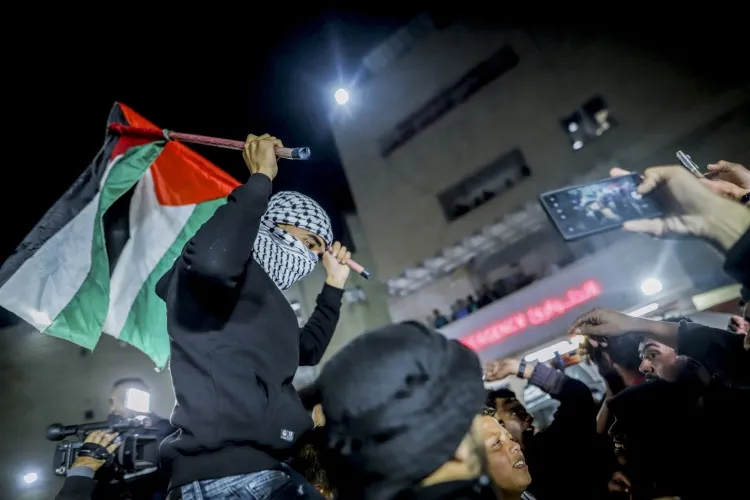Gaza Ceasefire: Fragile Peace or Path to Escalation?
The ceasefire in Gaza is hanging by a thread as tensions escalate once again. Hamas recently freed three Israeli hostages in exchange for over 300 Palestinian prisoners, raising questions about the sustainability of this fragile peace. With the involvement of international mediators, especially the United States and Saudi Arabia, the situation remains uncertain. This article dives into the complexities surrounding the ceasefire, the potential for long-term peace, and the role of global powers in shaping the future of Gaza.

Hostage Exchange and Ceasefire Fragility
In a significant development, Hamas released three Israeli hostages onto a stage in the southern Gaza city of Khan Yunis, in front of a large crowd. The hostages—Sagui Deelen (Israeli-American), Sasha Trofanov (Israeli-Russian), and ER Horn (Israeli-Argentinian)—were handed over to the Red Cross. The release came after negotiations that saw Israel free over 300 Palestinians detained in Israeli prisons, some for charges linked to terrorism. While this exchange offers a glimmer of hope, the ceasefire remains precarious. Israel's decision to free 369 Palestinian prisoners has been met with mixed reactions, with some questioning the long-term impact of such moves.
The uncertainty deepened when Hamas demanded that the United States, as a mediator in the Gaza peace talks, ensure Israel adheres to the ceasefire and releases more hostages. This highlights the deep-seated distrust between the parties involved, with both sides accusing the other of violating agreements.
Trump's Controversial Peace Proposal
In the midst of these developments, former U.S. President Donald Trump’s remarks regarding the future of Gaza have stirred significant controversy. Trump suggested that Gaza could be redeveloped into a "Riviera of the Middle East," but his plan included the expulsion of Palestinians, which Egypt and Jordan have vehemently rejected. This proposal, which also includes a potential summit with Saudi Arabia, reflects Trump's long-standing ties with the kingdom and his belief in Saudi Arabia’s role as a key player in resolving Middle East conflicts. However, the practicality of this plan remains questionable.
Saudi Arabia’s Role and Regional Dynamics
Saudi Arabia's role in mediating the Gaza conflict has gained prominence, with Crown Prince Mohammed bin Salman positioning the kingdom as a leading power in West Asia. Reports suggest that Trump’s business dealings in Saudi Arabia, worth hundreds of millions of dollars, may influence his approach to the region. Saudi Arabia’s diplomatic efforts are being closely watched, as its stance on relocating Palestinians from Gaza to Egypt or Jordan could have significant repercussions for the region’s stability.
Experts, such as Adrien Cel from the Arabian Peninsula Institute, have expressed skepticism about the prospects of this ceasefire lasting. While Israel has shown goodwill by releasing prisoners, many remain doubtful that Hamas can continue its hostage exchange strategy without exhausting its options. The long-term peace prospects seem unclear, especially given the historical complexities surrounding Gaza.
Potential for Long-Term Peace
The road to lasting peace in Gaza is riddled with challenges. The idea of relocating Palestinians to Egypt or Jordan, as suggested by Trump, is fraught with dangers. Such a move could destabilize these neighboring countries, whose political systems are already under strain. Additionally, Qatar, which has long supported Hamas, may be seen as better suited to bear the burden of peacekeeping, given its significant financial backing of Hamas.
The decades-long conflict between Israel and Hamas has shown that temporary ceasefires are often followed by flare-ups of violence. The international community must weigh the risks of further entrenching divisions versus the potential for a comprehensive peace agreement that addresses the root causes of the conflict.
Conclusion
As the Gaza ceasefire hangs in the balance, the international community faces a critical moment. With leaders like Donald Trump and Saudi Crown Prince Mohammed bin Salman asserting their influence, the future of Gaza is uncertain. The success of the ceasefire and the broader peace process hinges on the ability of global powers to navigate the complexities of regional politics and ensure that the agreements made are followed through. The road to peace may be long and fraught with obstacles, but the ongoing dialogue offers a glimmer of hope that a solution could eventually emerge.
For the latest updates on the situation in Gaza, stay tuned to our blog and follow us.
What's Your Reaction?















